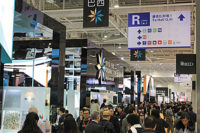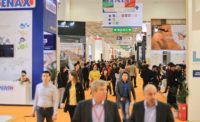
Atelier Pierre De Bourgogne - a state-of-the-art fabrication plant for French limestone - was recently established in the Burgundy region of France. Its principal owners are Mario Levak and Franck Pecceu - who also own Polystone, a stone importing company based in Oakland, CA - and Fabrice Descombes.
Located in the heart of the limestone-quarrying region of Burgundy, France, Atelier Pierre De Bourgogne began production at its state-of-the-art fabrication facility in December 2005. And to ensure the long-term success of this endeavor, it invested in the latest generation of stoneworking technology.
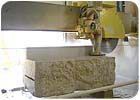
The Simec blockcutter has two blades and cuts in two steps: the two vertical blades cut down up to 2 feet in one pass, and then a horizontal blade cuts the bottom of the pass.
The other owner of Atelier Pierre De Bourgogne, Fabrice Descombes, had a different reason for wanting to build the factory with Polystone. Descombes owned a stone restoration company with his uncle, Franco Scandola, which specialized in restoring historical stone monuments, and he wanted to move on from that business and become more involved in the production of stone. This change would also help Descombes to better and more efficiently utilize the limestone quarry he owned.
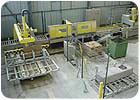
Tiles and panels are fabricated on Simec's completely automated tile production line.
The establishment of a fabrication plant also fit well with the owners' stone contracting business. “We had already started a stone installation company, Omnistone Masonry, Inc., with an experienced third partner, and now that Polystone is a shareholder in Atelier Pierre de Bourgogne, we can control all steps of the process - from quality control to production scheduling and communication,†explained Pecceu. “All of this enhances and increases our level of service and enables us to offer better pricing.â€
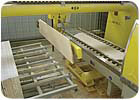
The small slabs or panels are automatically loaded from the block cutter onto the tile line using robot-controlled vacuum lifters.
A well-planned space
Walking through the factory, visitors can immediately see that the owners had a very specific plan and a very targeted audience. The factory is mainly set up to manufacture tiles and panels (expected to account for approximately 90% of their production) with a maximum size of 24 x 36 inches (610 x 914 mm) and a minimum of 8 x 8 inches (200 x 200 mm). The maximum thickness is 1 ½ inches, and the minimum is 3/8 inch on most limestone varieties. One material they offer, Roquemaillère Gris, a gray and blue limestone from Nîmes, is offered with a minimum thickness of ¼ inch (7 mm). The company also handles cut-to-size orders, odd-sized slabs and some cubic products.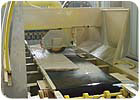
Strips are trimmed as needed, and the resulting waste is automatically removed from the line.
Other than the diamond wire saw, all of the remaining equipment was supplied by Simec of Italy. From the wire saw, located outside, the blocks move inside to the Simec NT2 2m Super Block Cutter, which is equipped with a customized 260 KW engine for hard stone because the factory plans to cut many hard stones as well as the local limestones, which are generally softer. Limestones from northern Burgundy, known as Chatillonais Stones, are often medium to hard. The Simec blockcutter has two blades and cuts in two steps: the two vertical blades cut down up to 2 feet in one pass, and then a horizontal blade cuts the bottom of the pass. The resulting pieces have a maximum thickness of 3 inches.

The trimmed pieces then go directly to the polishing line (suitable for limestone and marble) and are then cut into tiles and squared.
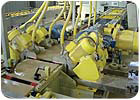
Polished beveled edges are a popular choice among the company's customers.
The finishes currently being offered by Atelier Pierre De Bourgogne are honed, polished, antiqued (brushed) and bushhammered.
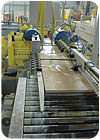
Tiles are produced at a maximum size of 24 x 36 inches and a minimum of 8 x 8 inches.
Water recycling was an important consideration for Atelier Pierre De Bourgogne, and it invested in a water treatment system and compressor from Omec of Italy. The company uses approximately 600 liters of water per minute and loses about 5%. All water is collected in a well and is then sent into a tower in which the sediment and mud settle to the bottom. After settling, the mud and sediment are subsequently compacted at a rate of 200 kilograms per square centimeter (2,845 psi), and it is then collected for use in the local farming industry to help balance the pH level of the soil. Supplemental water needed for the factory is rainwater collected from their roof.
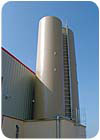
Atelier Pierre De Bourgogne also invested in a water treatment system and compressor from Omec of Italy.
Slab production is sub-contracted to an outside company that also processes some of the more intricate three-dimensional work that cannot be manufactured at the new factory. “We have very good working relationships with other stone companies in the area, so it's easy for us to utilize their capabilities,†said Descombes.
The company's primary market will be importers and the architectural community, mainly for architectural project work.
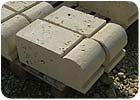
Atelier Pierre De Bourgogne also offers three-dimensional stone products.
Stone materials
Descombes owns one quarry for Darcy limestone, which is located across the road from the factory, and the plant is cutting approximately six different materials, mostly from Burgundy. The Darcy quarry is operated like the majority of quarries in Burgundy, which are different than most quarries in the world. The company extracts only about 500 cubic meters at a time for nearly two months, and then waits until it needs more material before quarrying again. Usually this occurs when they have approximately 100 cubic meters of material left. Most of the quarries in the area are similar in that they are small quarries, and the owners sub-contract the actual quarry operations. This means that they do not own the quarrying equipment, and instead have the quarry operators bring their machinery in and handle the excavation process. This process includes mainly horizontal quarrying; they do not go very deep into the quarry because most of the best material is near the top. Additionally, all quarry owners are required to fill in the quarry and restore the land back to its original agricultural use as they move to a new area.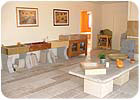
The facility also includes a showroom area where customers can view finished products.
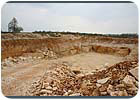
Descombes owns one quarry for Darcy limestone, which is located across the road from the factory.
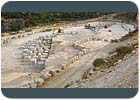
Recently, Atelier Pierre De Bourgogne signed an exclusive distribution agreement with Guillaume Allier, owner of the Roquemaillère quarry, and this agreement is particularly important for Polystone because Roquemaillère Gris is well suited for the American market.
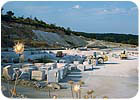
The extraction of Roquemaillère Gris is unique in that the waste from quarrying is extremely low, estimated at 15%.
